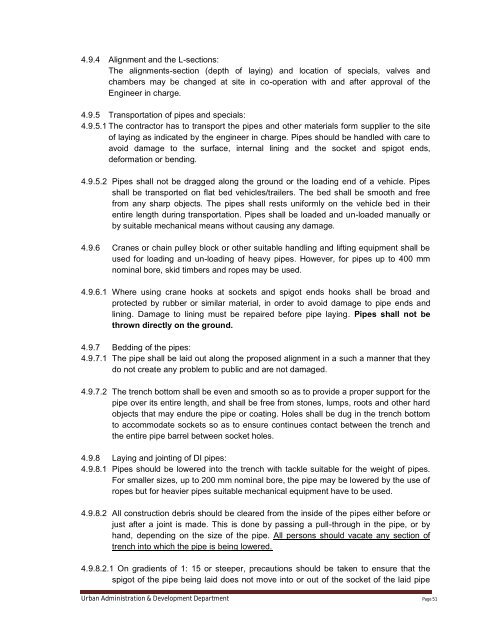Specifications Part 1 - Water Supply, Sewerage and Tube Well Works
Specifications Part 1 - Water Supply, Sewerage and Tube Well Works
Specifications Part 1 - Water Supply, Sewerage and Tube Well Works
You also want an ePaper? Increase the reach of your titles
YUMPU automatically turns print PDFs into web optimized ePapers that Google loves.
4.9.4 Alignment <strong>and</strong> the L-sections:The alignments-section (depth of laying) <strong>and</strong> location of specials, valves <strong>and</strong>chambers may be changed at site in co-operation with <strong>and</strong> after approval of theEngineer in charge.4.9.5 Transportation of pipes <strong>and</strong> specials:4.9.5.1 The contractor has to transport the pipes <strong>and</strong> other materials form supplier to the siteof laying as indicated by the engineer in charge. Pipes should be h<strong>and</strong>led with care toavoid damage to the surface, internal lining <strong>and</strong> the socket <strong>and</strong> spigot ends,deformation or bending.4.9.5.2 Pipes shall not be dragged along the ground or the loading end of a vehicle. Pipesshall be transported on flat bed vehicles/trailers. The bed shall be smooth <strong>and</strong> freefrom any sharp objects. The pipes shall rests uniformly on the vehicle bed in theirentire length during transportation. Pipes shall be loaded <strong>and</strong> un-loaded manually orby suitable mechanical means without causing any damage.4.9.6 Cranes or chain pulley block or other suitable h<strong>and</strong>ling <strong>and</strong> lifting equipment shall beused for loading <strong>and</strong> un-loading of heavy pipes. However, for pipes up to 400 mmnominal bore, skid timbers <strong>and</strong> ropes may be used.4.9.6.1 Where using crane hooks at sockets <strong>and</strong> spigot ends hooks shall be broad <strong>and</strong>protected by rubber or similar material, in order to avoid damage to pipe ends <strong>and</strong>lining. Damage to lining must be repaired before pipe laying. Pipes shall not bethrown directly on the ground.4.9.7 Bedding of the pipes:4.9.7.1 The pipe shall be laid out along the proposed alignment in a such a manner that theydo not create any problem to public <strong>and</strong> are not damaged.4.9.7.2 The trench bottom shall be even <strong>and</strong> smooth so as to provide a proper support for thepipe over its entire length, <strong>and</strong> shall be free from stones, lumps, roots <strong>and</strong> other hardobjects that may endure the pipe or coating. Holes shall be dug in the trench bottomto accommodate sockets so as to ensure continues contact between the trench <strong>and</strong>the entire pipe barrel between socket holes.4.9.8 Laying <strong>and</strong> jointing of DI pipes:4.9.8.1 Pipes should be lowered into the trench with tackle suitable for the weight of pipes.For smaller sizes, up to 200 mm nominal bore, the pipe may be lowered by the use ofropes but for heavier pipes suitable mechanical equipment have to be used.4.9.8.2 All construction debris should be cleared from the inside of the pipes either before orjust after a joint is made. This is done by passing a pull-through in the pipe, or byh<strong>and</strong>, depending on the size of the pipe. All persons should vacate any section oftrench into which the pipe is being lowered.4.9.8.2.1 On gradients of 1: 15 or steeper, precautions should be taken to ensure that thespigot of the pipe being laid does not move into or out of the socket of the laid pipeUrban Administration & Development Department Page 51
















